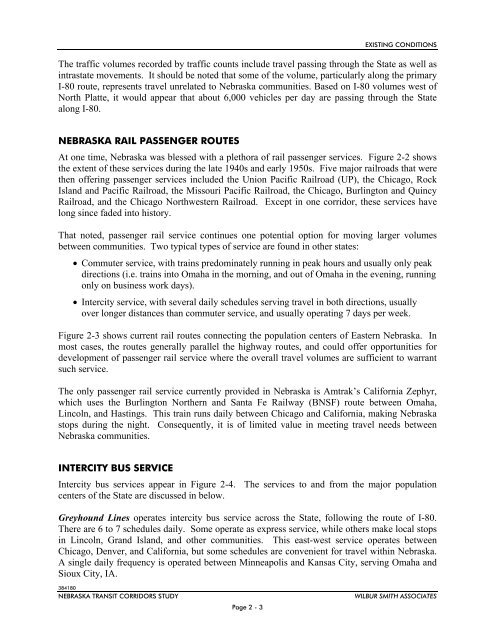NTRAC Final Study - Nebraska Department of Roads - State of ...
NTRAC Final Study - Nebraska Department of Roads - State of ...
NTRAC Final Study - Nebraska Department of Roads - State of ...
Create successful ePaper yourself
Turn your PDF publications into a flip-book with our unique Google optimized e-Paper software.
EXISTING CONDITIONS<br />
The traffic volumes recorded by traffic counts include travel passing through the <strong>State</strong> as well as<br />
intrastate movements. It should be noted that some <strong>of</strong> the volume, particularly along the primary<br />
I-80 route, represents travel unrelated to <strong>Nebraska</strong> communities. Based on I-80 volumes west <strong>of</strong><br />
North Platte, it would appear that about 6,000 vehicles per day are passing through the <strong>State</strong><br />
along I-80.<br />
NEBRASKA RAIL PASSENGER ROUTES<br />
At one time, <strong>Nebraska</strong> was blessed with a plethora <strong>of</strong> rail passenger services. Figure 2-2 shows<br />
the extent <strong>of</strong> these services during the late 1940s and early 1950s. Five major railroads that were<br />
then <strong>of</strong>fering passenger services included the Union Pacific Railroad (UP), the Chicago, Rock<br />
Island and Pacific Railroad, the Missouri Pacific Railroad, the Chicago, Burlington and Quincy<br />
Railroad, and the Chicago Northwestern Railroad. Except in one corridor, these services have<br />
long since faded into history.<br />
That noted, passenger rail service continues one potential option for moving larger volumes<br />
between communities. Two typical types <strong>of</strong> service are found in other states:<br />
Commuter service, with trains predominately running in peak hours and usually only peak<br />
directions (i.e. trains into Omaha in the morning, and out <strong>of</strong> Omaha in the evening, running<br />
only on business work days).<br />
Intercity service, with several daily schedules serving travel in both directions, usually<br />
over longer distances than commuter service, and usually operating 7 days per week.<br />
Figure 2-3 shows current rail routes connecting the population centers <strong>of</strong> Eastern <strong>Nebraska</strong>. In<br />
most cases, the routes generally parallel the highway routes, and could <strong>of</strong>fer opportunities for<br />
development <strong>of</strong> passenger rail service where the overall travel volumes are sufficient to warrant<br />
such service.<br />
The only passenger rail service currently provided in <strong>Nebraska</strong> is Amtrak’s California Zephyr,<br />
which uses the Burlington Northern and Santa Fe Railway (BNSF) route between Omaha,<br />
Lincoln, and Hastings. This train runs daily between Chicago and California, making <strong>Nebraska</strong><br />
stops during the night. Consequently, it is <strong>of</strong> limited value in meeting travel needs between<br />
<strong>Nebraska</strong> communities.<br />
INTERCITY BUS SERVICE<br />
Intercity bus services appear in Figure 2-4. The services to and from the major population<br />
centers <strong>of</strong> the <strong>State</strong> are discussed in below.<br />
Greyhound Lines operates intercity bus service across the <strong>State</strong>, following the route <strong>of</strong> I-80.<br />
There are 6 to 7 schedules daily. Some operate as express service, while others make local stops<br />
in Lincoln, Grand Island, and other communities. This east-west service operates between<br />
Chicago, Denver, and California, but some schedules are convenient for travel within <strong>Nebraska</strong>.<br />
A single daily frequency is operated between Minneapolis and Kansas City, serving Omaha and<br />
Sioux City, IA.<br />
384180<br />
NEBRASKA TRANSIT CORRIDORS STUDY<br />
Page 2 - 3<br />
WILBUR SMITH ASSOCIATES

















